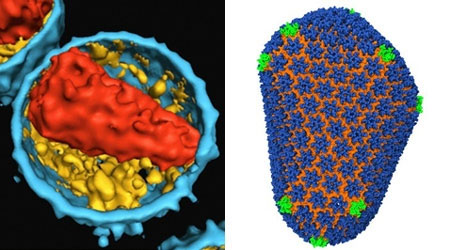First decoding the internal structure of the HIV virus
Scientists have for the first time decoded the complex structure of the protein envelope (capsid) inside the HIV virus. They also figured out how exactly these components of the crust bind together at the atomic level.
Until recently, we knew that capsid was a conical shell located inside the outer membrane of the HIV virus. The composition of capsid consists of adherent protein subunits in a grid form.

The HIV virus is escaping from a white blood cell.(Photo: SPL)
Because the structure is quite large, it is asymmetrical and asynchronous, so common techniques for decoding this structure have failed. However, the research team from the University of Pittsburgh created a miracle using advanced scanning techniques and a supercomputer to calculate how 1,300 proteins connect together to form a shell. capsid cone.
According to research reports published in the journal Nature, key interactions that have just been discovered between molecules have helped create the cohesion and stability of the capsid protective shell. The team found that their findings could be used to make new drugs, attacking these key links to fight HIV drug resistance.
Dr. Peijun Zhang, professor of structural biology at the University of Pittsburgh Medical School and head of research, emphasized: "Capsid is extremely important for HIV proliferation, so, Understanding its detailed structure can help us create new drugs that can treat or prevent HIV infection. "

The computer simulation of the position (left) and the complex structure of the capsid shell inside the HIV virus.
Professor Zhang further explained that capsid shells must always maintain their intact state to protect the genome of HIV and bring it into human cells. However, once it gets inside human cells, the capsid will divide to release the ingredients, helping the virus replicate. Drugs that neutralize capsid by preventing it from combining or separating can prevent HIV virus from increasing the number in the patient's body.
The rapid pace of change in HIV has caused viral resistance to become a major problem. Ms. Zhang said that her research with her colleagues opened the prospect of a powerful alternative treatment for today's popular HIV therapies, which work by attacking the most enzymes. determined.
- The player decodes the enzyme structure of the AIDS virus
- Add an internal virus that causes turmoil through YM
- Decoding the mysterious geological structure in America
- Answer the mysterious structure in the Amazon forest
- The US finds about one fifth of the HIV gene structure
- The first successful decoding of the wheat genome structure
- Decoding the world's longest-lived human gene
- How do scientists capture a virus image?
- The internal virus spreads the fastest ever
- Decipher the mystery of the Earth's inner core
- Foam hemostatic internal injury
- Japan found the structure of anti-HIV protein molecule
 Green tea cleans teeth better than mouthwash?
Green tea cleans teeth better than mouthwash? Death kiss: This is why you should not let anyone kiss your baby's lips
Death kiss: This is why you should not let anyone kiss your baby's lips What is salmonellosis?
What is salmonellosis? Caution should be exercised when using aloe vera through eating and drinking
Caution should be exercised when using aloe vera through eating and drinking Changing patterns of HIV infection in Vietnam
Changing patterns of HIV infection in Vietnam  HIV vaccine becomes a reality, new hope for millions of people has come
HIV vaccine becomes a reality, new hope for millions of people has come  Scientists claim to be able to cut the HIV virus from cells
Scientists claim to be able to cut the HIV virus from cells  Discovered super-antibodies that can neutralize HIV
Discovered super-antibodies that can neutralize HIV  New method can cure AIDS with just one injection
New method can cure AIDS with just one injection  Gene-editing drug development can cure HIV/AIDS?
Gene-editing drug development can cure HIV/AIDS? 